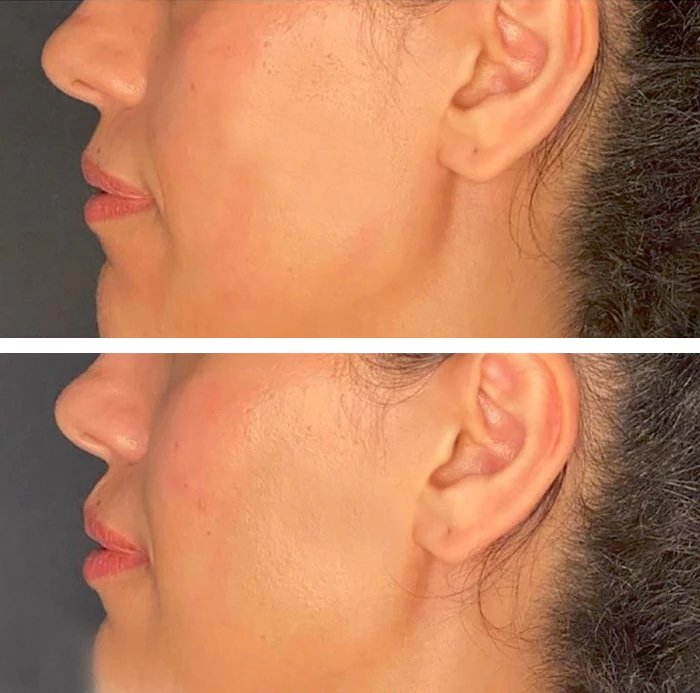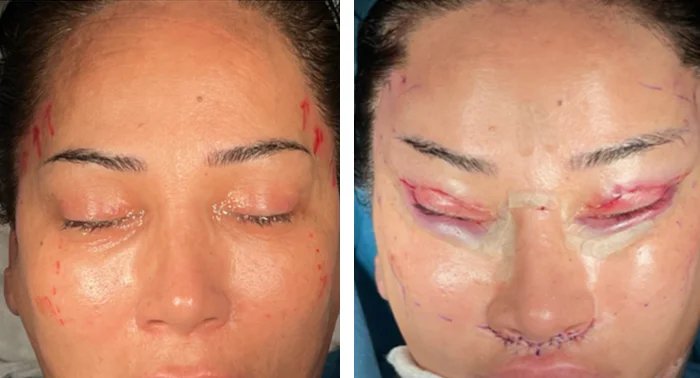What is a cheek lift?
A cheek lift, also known as a mid-face lift, is a cosmetic surgical procedure performed to improve the appearance of the cheeks and mid-face area. It is commonly done to address concerns such as sagging cheeks, loss of volume, and signs of aging in the mid-face region.
The primary goal of a cheek lift is to restore a more youthful and rejuvenated appearance to the face. As we age, the cheeks tend to lose volume and sag, resulting in a tired or gaunt appearance. A cheek lift can help address these concerns by lifting and repositioning the underlying tissues of the cheeks, enhancing facial contours, and restoring facial harmony.
During the procedure, a plastic surgeon will typically make incisions either within the hairline or inside the mouth, allowing access to the underlying tissues of the cheeks. The surgeon will then lift and tighten these tissues, repositioning them to a more youthful position. In some cases, facial implants or fat transfer may be used to enhance the volume and projection of the cheeks.
Who is a cheek lift suitable for?
A cheek lift is suitable for individuals who are experiencing sagging cheeks, loss of volume in the mid-face area, or signs of aging in the cheeks. It can be an ideal option for those who desire a more youthful and rejuvenated appearance in their mid-face region.
The following individuals may benefit from a mid-face lift:
- Age-related changes: As we age, the cheeks tend to lose volume and sag, resulting in a tired or gaunt appearance. A cheek lift can address these age-related changes by lifting and repositioning the underlying tissues, restoring a more youthful and refreshed look.
- Sagging cheeks: If you have sagging cheeks due to factors such as aging, genetics, or weight loss, a cheek lift can help lift and tighten the tissues, improving the contours of the cheeks and restoring a more youthful appearance.
- Loss of cheek volume: Some individuals may have naturally flat or underdeveloped cheeks, while others may experience volume loss over time. A cheek lift can restore volume to the cheeks, enhancing facial fullness and creating a more balanced and harmonious facial appearance.
- Facial asymmetry: If you have noticeable asymmetry or imbalance in your cheeks, a cheek lift can help address these concerns by repositioning and reshaping the tissues, creating a more symmetrical and harmonious facial appearance.
- Desire for facial rejuvenation: Individuals who desire an overall facial rejuvenation may opt for a mid-face lift as part of their aesthetic goals. By lifting and tightening the cheeks, this procedure can contribute to a more youthful and refreshed look, reducing the appearance of wrinkles and sagging skin.
It is important to consult with a qualified plastic surgeon to determine if you are a suitable candidate for a cheek lift. They will assess your facial anatomy, discuss your concerns and goals, and recommend the most appropriate treatment plan tailored to your individual needs.
What are the benefits?
A cheek lift offers several benefits for individuals seeking to improve the appearance of their cheeks and mid-face area. Some of the key benefits of a cheek lift include:
- Restored facial harmony: A cheek lift can address sagging cheeks and mid-face droop, helping to restore balance and harmony to the facial features. By lifting and repositioning the cheeks, the overall facial appearance can appear more balanced and aesthetically pleasing.
- Enhanced cheekbone definition: A mid-facelift can improve the definition and prominence of the cheekbones. By lifting the underlying tissues and adding volume if necessary, the cheekbones can become more sculpted, accentuating the natural contours of the face.
- Reduced nasolabial folds: Nasolabial folds, also known as smile lines or laugh lines, are the creases that run from the sides of the nose to the corners of the mouth. By lifting the cheeks, a cheek lift can reduce the appearance of these folds, resulting in a smoother and more youthful look.
- Improved facial contours: A cheek lift can enhance the overall facial contours, creating a more youthful and rejuvenated appearance. By restoring volume and lifting sagging tissues, the cheeks can regain their natural fullness and contribute to a more defined facial structure.
- Rejuvenated and youthful appearance: One of the primary benefits of a cheek lift is the rejuvenating effect it can have on the face. By addressing signs of aging such as sagging cheeks and loss of volume, a cheek lift can help individuals achieve a more youthful and refreshed look, boosting their self-confidence.
It's important to note that the specific benefits of a cheek lift may vary depending on individual factors and the techniques used during the procedure. Consultation with a qualified plastic surgeon is necessary to discuss your specific concerns, goals, and the potential benefits that can be achieved through a cheek lift.
How is cheek lift surgery performed?
A cheek lift or mid-facelift is typically performed by a qualified plastic surgeon. The specific technique used may vary depending on the surgeon's expertise and the individual patient's needs. However, the general steps involved in performing a cheek lift include:
- Consultation: The process begins with a thorough consultation between the patient and the plastic surgeon. During this consultation, the surgeon will assess the patient's facial anatomy, discuss their concerns and goals, and determine if a cheek lift is the appropriate procedure to address their specific needs.
- Anesthesia: Before the actual procedure, the patient will be administered anesthesia to ensure their comfort throughout the surgery. The type of anesthesia used can vary, and it will be discussed and decided upon during the pre-operative consultation.
- Incision: The surgeon will make incisions either within the hairline or inside the mouth, depending on the specific technique chosen and the patient's anatomy. These incisions are strategically placed to minimize visible scarring.
- Tissue repositioning: Through the incisions, the surgeon will lift and reposition the underlying tissues of the cheeks. This may involve tightening and reattaching the sagging muscles or repositioning fat pads for enhanced volume and contour.
- Additional procedures: Depending on the patient's needs and desired outcome, additional procedures such as fat grafting or facial implant placement may be performed to further enhance the volume and projection of the cheeks.
- Incision closure: Once the necessary adjustments have been made, the surgeon will carefully close the incisions using sutures or other closure techniques. These incisions are typically discreet and well-hidden to minimize visible scarring.
- Recovery and aftercare: After the procedure, the patient will be given post-operative instructions to follow, including information on medication, wound care, and follow-up appointments. Recovery time can vary, but it is important to allow adequate healing and follow the surgeon's guidance for a smooth recovery.
It's important to note that the specific techniques and steps involved in a cheek lift may vary depending on the surgeon's approach and the patient's unique circumstances. It is essential to consult with a qualified and experienced plastic surgeon who can provide personalized recommendations and perform the procedure safely and effectively.
Incision techniques
In a cheek lift procedure, there are different incision techniques that a plastic surgeon may employ, depending on factors such as the patient's anatomy and the desired outcome. The two main incision techniques used for a cheek lift are:
- Temporal incision Technique: This technique involves making incisions within the hairline near the temples. The incisions are typically hidden within the natural creases of the scalp. Through these incisions, the surgeon can access the underlying tissues of the mid-face and cheeks to lift and reposition them.
The temporal incision technique is often preferred for patients with minimal sagging and those who require a more subtle lift. It provides access to the upper portion of the cheek and can address mild to moderate cheek sagging. This technique may be combined with other incision approaches for comprehensive facial rejuvenation.
- Transoral incision technique: Also known as the buccal incision technique, this approach involves making incisions inside the mouth along the upper gum line, near the cheeks. The advantage of this technique is that it avoids visible external incisions, making it suitable for patients concerned about visible scarring.
Through the transoral incisions, the surgeon can access the underlying tissues of the cheeks and mid-face. They can then lift and reposition these tissues to achieve the desired results. This technique is often used for patients with moderate to severe cheek sagging or those who require more extensive lifting and volumization of the mid-face.
The choice of incision technique will depend on individual factors such as the patient's facial anatomy, the extent of sagging or volume loss, and the surgeon's expertise. During the consultation, the plastic surgeon will evaluate the patient's specific needs and discuss the most suitable incision technique for their case.
It's important to note that the incisions made during a cheek lift are typically well-placed and discreet, aiming to minimize visible scarring. The surgeon will provide instructions for proper wound care and scar management during the recovery period to promote optimal healing and minimize scarring.
What to expect before surgery
Before undergoing a cheek lift surgery, there are several steps involved in preparation to ensure a smooth and successful procedure. Here is an overview of what to expect during the pre-surgery preparation phase:
- Initial consultation: The process begins with an initial consultation with a plastic surgeon. During this consultation, you will discuss your goals, concerns, and expectations for the cheek lift surgery. The surgeon will evaluate your facial anatomy, medical history, and any potential risk factors to determine if you are a suitable candidate for the procedure.
- Medical evaluation: Before the surgery, a comprehensive medical evaluation will be conducted. This may include a physical examination, a review of medical history, and possibly additional tests or assessments to ensure you are in good overall health for the surgery.
- Discussion of expectations and outcomes: The surgeon will discuss the expected outcomes of the cheek lift surgery, including the potential risks and complications. They will explain the procedure in detail, including the incision techniques, anesthesia options, and the recovery process. This is the time to ask any questions or express any concerns you may have.
- Pre-operative instructions: You will receive detailed instructions from the surgeon to follow in the days leading up to the surgery. These instructions may include guidelines on medications to avoid, fasting requirements before the surgery, and any necessary lifestyle modifications.
- Medication adjustments: If you are currently taking any medications or supplements, the surgeon may advise you to adjust or temporarily stop certain medications that can interfere with the surgery or the healing process. It's important to disclose all medications, including over-the-counter drugs and herbal supplements, to your surgeon during the consultation.
- Lifestyle adjustments: It may be recommended to refrain from smoking or consuming alcohol for a certain period before the surgery, as these factors can impact the healing process. Additionally, maintaining a healthy lifestyle, including a balanced diet and regular exercise, can contribute to optimal surgical outcomes.
- Arrange for support and transportation: As cheek lift surgery is typically performed on an outpatient basis, it is important to arrange for someone to drive you home after the procedure. Having a support system in place during the initial recovery phase can also be beneficial.
- Pre-operative appointments: You may have additional pre-operative appointments scheduled, such as a pre-surgical assessment or lab work, to ensure that you are fully prepared for the procedure.
It is crucial to closely follow the instructions provided by your plastic surgeon to ensure a safe and successful cheek lift surgery. By properly preparing for the procedure, you can help optimize your results and minimize the risk of complications.
What to expect after surgery
After undergoing a cheek lift surgery, it is important to be prepared for the recovery process. Here is an overview of what to expect after the surgery:
- Immediate post-operative period: You will be closely monitored in a recovery area immediately after the surgery. The surgical site may be covered with dressings or bandages to protect the incisions. You may experience some swelling, bruising, and discomfort in the treated area.
- Discomfort and pain management: It is common to experience some degree of discomfort or pain after the surgery. Your plastic surgeon will prescribe pain medication or recommend over-the-counter pain relievers to help manage any discomfort. It is important to follow the prescribed pain management plan and report any severe or unusual pain to your surgeon.
- Swelling and bruising: Swelling and bruising are common side effects of cheek lift surgery. They typically peak within the first few days and gradually subside over several weeks. Applying cold compresses and keeping your head elevated can help minimize swelling. Your surgeon may also recommend specific techniques or medications to manage swelling and bruising.
- Dressings and incision care: Your surgeon will provide specific instructions on how to care for the incisions and any dressings applied. It is important to keep the incisions clean and dry to prevent infection. Your surgeon may schedule follow-up appointments to monitor the healing progress and remove any sutures or dressings.
- Restricted activities: Your surgeon will provide specific guidelines on activities to avoid during the initial recovery period. This may include avoiding strenuous exercise, heavy lifting, or activities that can put pressure on the treated area. It is crucial to follow these instructions to promote proper healing and minimize the risk of complications.
- Gradual return to normal routine: While recovery times can vary, most individuals can gradually return to their normal routine within a few weeks after the surgery. However, it is important to listen to your body and not rush the healing process. It is advisable to avoid excessive sun exposure and protect the treated area from direct sunlight during the healing phase.
- Final results: It is important to note that the final results of a cheek lift may not be immediately apparent. It can take several weeks to months for the swelling to fully resolve and for the tissues to settle into their new position. The full benefits of the surgery, including improved cheek contours and a more youthful appearance, will become more noticeable as the healing progresses.
It is crucial to closely follow your surgeon's post-operative instructions, attend all follow-up appointments, and communicate any concerns or questions you may have during the recovery period. This will ensure optimal healing and help achieve the desired results from the cheek lift surgery.
Potential risks and complications
Like any surgical procedure, a cheek lift surgery carries certain risks and the possibility of complications. It is important to be aware of these potential risks and discuss them with your plastic surgeon before proceeding with the surgery. While complications are rare, they can include:
- Infection: There is a risk of developing an infection at the surgical site. Your surgeon will provide instructions on how to care for the incisions and minimize the risk of infection. Signs of infection can include increased pain, redness, swelling, or discharge from the incision site.
- Bleeding: Excessive bleeding during or after the surgery can occur, although it is uncommon. Your surgeon will take precautions to minimize the risk of bleeding, and any significant bleeding should be reported to your surgeon immediately.
- Hematoma: A hematoma is a collection of blood that can accumulate under the skin, causing swelling and discomfort. If a hematoma develops, your surgeon may need to drain it to alleviate the pressure and promote healing.
- Scarring: While efforts are made to minimize scarring, there is a possibility of visible scarring at the incision sites. Most incisions are strategically placed to be as inconspicuous as possible, and they typically fade over time. Proper wound care and following your surgeon's post-operative instructions can help optimize scar healing.
- Nerve injury: There is a small risk of nerve injury during the surgery, which can result in temporary or, in rare cases, permanent numbness, tingling, or weakness in the affected area. Your surgeon will take precautions to minimize this risk, but it is important to be aware of this potential complication.
- Asymmetry or unsatisfactory results: In some cases, the final results of a cheek lift may not meet your expectations. There is a possibility of asymmetry or dissatisfaction with the aesthetic outcome. It is important to have realistic expectations and communicate your goals clearly with your surgeon during the consultation process.
- Adverse reaction to anesthesia: While rare, there is a possibility of an adverse reaction to anesthesia used during the surgery. Your anesthesiologist will evaluate your medical history and take necessary precautions to minimize this risk.
It is crucial to choose a qualified and experienced plastic surgeon to minimize the risks associated with cheek lift surgery. Your surgeon will discuss these potential risks and complications with you during the consultation process and provide guidance on how to mitigate them. By following your surgeon's instructions and closely monitoring your recovery, you can help minimize the risks and optimize the outcome of the procedure.
Cheek lift cost
The cost of a cheek lift surgery can vary depending on several factors, including the geographic location, the surgeon's experience and reputation, the complexity of the procedure, and the specific techniques used. Other factors that can influence the cost include surgical facility fees, anesthesia fees, pre-operative tests, post-operative care, and any additional medications or garments required.
On average, the cost of a mid-face lift surgery in the United States can range from $5,000 to $10,000 or more. However, it is important to note that this is just an estimate, and the actual cost can be higher or lower based on the factors mentioned above.
It is recommended to consult with a qualified plastic surgeon to discuss your specific needs and goals. During the consultation, the surgeon will evaluate your facial anatomy, discuss the desired outcome, and provide a personalized treatment plan along with a detailed cost estimate. Additionally, it is important to inquire about any potential financing options or payment plans that may be available to make the procedure more affordable.
When considering the cost of a cheek lift surgery, it is crucial to prioritize the qualifications and experience of the surgeon, as well as the safety and quality of the surgical facility, over the cost alone. Choosing a skilled and reputable surgeon can help ensure a successful and satisfactory outcome while minimizing the risk of complications.
How is a cheek lift different from a facelift?
A cheek lift and a facelift are both surgical procedures aimed at rejuvenating the face, but they target different areas and have distinct goals. A cheek lift, also known as a midface lift or a mid-cheek lift, specifically targets the midface region. It focuses on lifting and repositioning the sagging or drooping tissues in the cheeks and the area between the lower eyelids and the mouth. The primary goal of a cheek lift is to restore volume and lift the cheeks, creating a more youthful and rejuvenated appearance. This procedure can help address midface sagging, deep nasolabial folds, and a hollowed or sunken appearance in the cheeks.
A facelift or rhytidectomy, by which we often mean a full facelift, is a more extensive procedure that addresses signs of aging in multiple areas of the face, including the cheeks, jowls, jawline, and neck. The primary goal of a facelift is to tighten and lift the skin and underlying tissues, reducing sagging, wrinkles, and jowls. It can also help improve the appearance of deep creases, such as nasolabial folds and marionette lines.
While a cheek lift primarily targets the midface region, a facelift provides more comprehensive rejuvenation by addressing multiple areas of the face and neck. The choice between a cheek lift and a facelift depends on the specific concerns and goals of the patient, as well as the surgeon's assessment of the individual's anatomy and aging patterns
FAQs
Is cheek lift surgery performed under general or local anesthesia?
Cheek lift surgery can be performed under either general anesthesia or local anesthesia with sedation, depending on the specific preferences of the patient and the surgeon's recommendation.
Can I combine a cheek lift with other procedures?
Yes, it is possible to combine a cheek lift with other cosmetic procedures, depending on your specific needs and goals. Many individuals choose to combine multiple procedures to achieve a more comprehensive facial rejuvenation. Some commonly combined procedures with a cheek lift include blepharoplasty, brow lift, fat transfer, Botox injection, and dermal fillers.
Does a cheek lift help with jowls?
Yes, a cheek lift can indirectly help with jowls by lifting and improving the overall facial structure, which can reduce the prominence of jowls and provide a more defined jawline. However, if jowls are a significant concern, a more comprehensive procedure such as a full facelift may be recommended.
Isn’t it better to have a cheek thread lift instead of a surgical cheek lift?
The choice between a cheek thread lift and a surgical cheek lift depends on various factors, including the desired outcome, the extent of sagging, and individual preferences. While a cheek thread lift is minimally invasive and has a shorter recovery time, a surgical mid-face lift can provide more significant and long-lasting results.
What is the best age for a cheek lift?
Generally, most individuals considering a cheek lift are in their 40s to 60s when they start experiencing noticeable signs of aging in the midface, such as sagging cheeks or deep nasolabial folds. However, there is no specific age limit for a mid-face lift, and the suitability for the procedure is determined on a case-by-case basis.
Will a cheek lift leave a scar on my face?
A cheek lift procedure may leave some scarring, but the extent and visibility of the scars can vary depending on the specific technique used and individual healing factors. Plastic surgeons typically make incisions in inconspicuous locations, such as within the hairline, behind the ear, or inside the mouth, to minimize the visibility of scars. When incisions are made within the hairline or behind the ear, the scars are often well-hidden and not easily noticeable. Incisions made inside the mouth may result in no visible external scarring.
Are cheek lift results permanent?
The results of a cheek lift procedure are not considered permanent. While a cheek lift can provide long-lasting improvements, the natural aging process will continue over time, and the effects of the procedure may gradually diminish. Factors such as genetics, lifestyle, and skincare routine can also affect the longevity of the results. However, a cheek lift can still provide significant and noticeable improvements that can last for several years.







